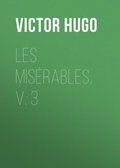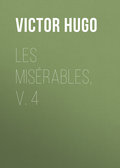
Виктор Мари Гюго
Ninety-Three
BOOK III
THE CONVENTION
I
THE CONVENTION
I
We are approaching the summit.
The Convention is before our eyes, and in the presence of this lofty eminence the gaze grows steady.
Nothing more towering ever rose above the human horizon. There is but one Himalaya, but one Convention.
The Convention may perhaps be called the culminating point in history.
During its lifetime – an assembly actually lives – one did not realize what it was. Its supreme grandeur was not appreciated by its contemporaries, who were too much terrified to be dazzled. Mediocrities and moderate hills levy no severe tax on one's admiration; but the majestic inspires a holy horror, whether it be the majesty of genius or of a mountain, an assembly or a masterpiece. Too close proximity excites alarm; every peak seems exaggerated, the ascent is fatiguing, and one loses breath in climbing its sharp acclivities, misses his footing on the slopes, and is wounded by the cragged surfaces, which in themselves are beauties; the foaming torrent indicates the presence of the chasm, the summit is veiled in clouds; whether ascending or descending, it is equally frightful, hence one feels the influence of terror rather than of admiration, – a kind of aversion to grandeur, which is a strange enough sensation. While gazing on the abyss, one cannot always appreciate its sublimity; the monster is more evident than the miracle. It was thus that men first judged the Convention. The purblind undertook to fathom an abyss whose depths could only be sounded by the eagle.
To-day we behold it in the perspective outlining the granite profile of the French Revolution against the calm and tragic background of the far-away heavens.
II
The 14th of July set the nation free.
The 10th of August hurled its thunderbolts.
The 21st of September founded a new era; for the 21st of September was the equinox, the equilibrium, Libra, – the balance-scales of Justice. According to the remark of Romme, the Republic was proclaimed beneath this sign of Equality and Justice, – heralded, so to speak, by a constellation.
The Convention is the first avatar of the people. It was the Convention that turned the new and glorious page, introducing the future of to-day.
Every idea requires a visible embodiment; every principle needs a habitation; a church means the four walls within which the Almighty has his dwelling-place; every dogma must have its temple. When the Convention became a fact, the first problem was to locate it.
At first it was established in the Manège, but afterwards at the Tuileries. Here they raised a platform and arranged scenery, painted in gray, by David; also, rows of benches and a square tribune; there were parallel pilasters, with massive plinths, and long rectangular stems, and square enclosures, into which the multitude crowded, and which were called public tribunes; a Roman velarium, and Grecian draperies; and amid these right angles and straight lines the Convention was installed, – a tempest confined within geometrical limits. On the tribune the red cap was painted in gray. At first the Royalists ridiculed this gray bonnet-rouge, this artificial hall, this pasteboard monument, this sanctuary of papier-mâché, this pantheon of mud and spittle. How quickly it was destined to vanish! The pillars were made of barrel-staves, the arches of thin deal boards, the bas-reliefs were mastic, the entablature was of pine, the statues were of plaster, the marble was painted, the walls were of canvas; and in this provisional shelter France has recorded deeds that can never be forgotten.
During the early sessions of the Convention the walls of the Hall of the Manège were covered with the advertisements with which Paris swarmed at the time of the return from Varennes. On one might be read: "The King returns. Whoever applauds him will be chastised; whoever insults him will be hung." On another: "Peace. Keep your hats on your heads. He is about to pass before his judges." On another: "The King took aim at the nation, but his weapon hung fire. Now the nation has its turn." On another: "The law! the law!" It was within these walls that the Convention sat in judgment on Louis XVI.
At the Tuileries, now called the Palais National, where the Convention had held its sessions from the 10th of May, 1793, the Assembly Hall occupied the space between the Pavillon de l'Horloge, called Pavillon Unité, and the Pavillon Marsan, called Pavillon Liberté. The Pavillon de Flore was now called Pavillon-Égalité. The Assembly Hall was accessible by the grand staircase of Jean Bullant. The entire ground-floor of the palace below the first story, occupied by the Assembly, was a kind of long guardroom, littered with the luggage and camp-beds of the various troops mounting guard over the Convention. The Assembly had a special guard of honor, called "the Grenadiers of the Convention."
A tricolored ribbon divided the palace occupied by the Assembly from the garden where the people passed in and out.
III
Let us finish our description of the Assembly Hall. Everything concerning this terrible place is of interest. The first object to attract one's attention on entering was a tall statue of Liberty, placed between two large windows. This hall, which was formerly the king's theatre, had now become the stage of Revolution. It was forty-two metres long, ten metres in width, and eleven in height. This elegant and superb hall built by Vigarani for the use of the courtiers was hidden beneath the rude timber-work which served to support the weight of the people in '93. The only point of support upon which this timber-work of the public tribunes rested, was a single post, which well deserves honorable mention. This post consisted of one solid piece, ten metres in circumference, and few caryatides have done an equal amount of work; for years it bore the severe pressure of revolution. It has supported applause, enthusiasm, insult, clamors and tumults, the tremendous chaos of wrath, the fury of insurrection, and never given way beneath its burden. After the Convention it witnessed the council of the Ancients. On the 18th Brumaire it was relieved. At that time Percier replaced this wooden pillar by columns of marble that did not last so long.
An architect's ideal is sometimes peculiar; that of the architect of the Rue de Rivoli was the curved path of a cannon-ball in its flight; the architect of Carlsruhe conceived the ideal of a fan; and the conception of the architect who built the hall where the Convention established itself on the 10th of May, 1793, was apparently a huge bureau drawer, for it was long as well as high and flat. A great semicircle had been added to one of the long sides of the parallelogram; this was the amphitheatre with seats for the representatives, but neither tables nor desks; Garan-Coulon, who wrote a great deal, used to write, resting his paper on his knee; facing the benches was the tribune, – before it the bust of Lepelletier-Saint-Fargeau, and behind it the president's arm-chair. The head of the bust projected slightly above the edge of the tribune, which afterwards was the cause of its removal.
The amphitheatre consisted of nineteen semicircular benches, rising one above the other, some of which had been lengthened in order to fit into the corners, by means of other benches cut off for the purpose.
In the semicircle beneath, at the foot of the tribunal, were the places of the ushers, and on the other side of the tribune hung a placard nine feet high, set in a black wooden frame, and bearing on its two pages, separated by a kind of sceptre, the Declaration of the rights of man. On the other side was an empty space which was afterwards occupied by a similar frame, containing the Constitution of the year II., with the two pages separated by a sword. Above the tribune, over the head of the orator, from a deep loge divided into two compartments and filled with People, floated three immense tricolored banners, arranged in a horizontal position, resting on an altar upon which could be read the following words: "The Law." Behind this altar rose, like the sentinel of freedom of speech, an enormous Roman fasces as tall as a column. Two colossal statues, placed erect against the wall, faced the representatives, – Lycurgus on the president's right hand, Solon on his left, with Plato towering above the Mountain. The statues stood on simple wooden blocks, resting on a long projecting cornice that encircled the hall, separating the people from the Assembly. The spectators leaned their elbows on this cornice.
The black wooden frame enclosing the proclamation of the Rights of Man reached to the cornice, interfering with the symmetry of the entablature, – an infraction of the straight line that made Chabot growl. "It is ugly," he said to Vadier.
The heads of the statues were decorated with wreaths of oak and laurel.
Green curtains, on which similar wreaths were painted in a deeper shade of the same color, fell in heavy folds from the surrounding cornice, draping the entire lower floor of the hall occupied by the Assembly. Above this drapery the wall was white and bare. In this wall, as if carved by a chisel, without moulding or ornament, were two stories of public tribunes, the square ones below, the round ones above; according to the rule-for the influence of Vitruvius was still acknowledge – the archivolts were superimposed upon the architraves. There were ten tribunes on each of the long sides of the hall, and two huge boxes at both ends; twenty-four in all. There sat the assembled crowd.
The spectators in the lower tribunes overflowed their bounds, grouping themselves on every projection along the cornice. A long iron bar, firmly fastened at the point of support, served as a rail to the upper tribunes, and protected the spectators from the pressure of the crowds that ascended the stairs. Once, however, a man who was pitched suddenly into the Assembly below escaped death by falling partly upon Massieu, Bishop of Beauvais; whereupon he exclaimed, "Really, a bishop has his use, then, after all!"
The hall of the Convention was large enough to contain two thousand persons, and on the days of insurrections even three thousand.
The Convention held two sessions, – one during the day and one in the evening.
The back of the president's chair was round, studded with gilt nails. His table was supported by four winged monsters with a single foot, who might have been supposed to have come forth from the Apocalypse to witness the Revolution. They seemed to have been unharnessed from Ezekiel's chariot to drag the tumbril of Samson.
On the president's table stood a huge bell, almost as large as a church-bell, a big copper inkstand, and a parchment portfolio, which contained the record of proceedings. The blood from many a severed head, borne aloft on the end of a pike, has dripped upon this table.
Nine steps led to the tribune. These steps were high, steep, and difficult of ascent; Gensonné once tripped in the act of mounting them. "It is like the staircase of a scaffold!" he said. "It is well to serve your apprenticeship!" cried Carrier.
In the corners of the hall, where the walls seemed rather bare, the architect had placed Roman fasces as ornaments, with the axe bound on the outside.
On the right and left of the tribune pedestals supported two candelabra twelve feet high, each bearing four pairs of Argand lamps. For each public box there was a similar candelabra; and on the pedestals of these candelabra circles were carved, which the people called "guillotine collars."
The seats of the Assembly, rising almost to the cornice of the tribunes, gave the representatives and the people an opportunity to chat with one another.
The exits of the tribunes opened into a labyrinth of corridors, often echoing with wild and tumultuous sounds.
The Convention, outgrowing the limits of the palace, ace, overflowed into the neighboring hotels of Longueville and Coigny. If we may credit Lord Bradford's letter, it was to the Hôtel Coigny that the royal furniture was removed after the 10th of August. It took two entire months to empty the Tuileries.
The committees were lodged in the vicinity of the hall: those of legislation, agriculture, and commerce at the Pavillon-Égalité; those of the navy, the colonies, finance, assignats, and public safety, at the Pavillon Liberté; the Committee of War was at the Pavillon-Unité.
The lodgings of the Committee of General Safety were accessible to those of the Public Safety through a dark corridor, lighted night and day by a lantern, – a passage-way for the spies of all parties, who came and went, talking in whispers.
The bar of the Convention had been changed several times. Usually it was at the right hand of the president.
At both ends of the hall the two vertical partitions that shut off the concentric semicircles of the amphitheatre on the right hand and on the left, allowed space enough between partition and wall for two long and narrow passages closed at either end by square doors, which afforded entrance and exit.
A door opening upon the Terrasse des Feuillants, and leading directly into the hall, served for the admittance of the representatives.
This hall, ineffectually lighted during the day by windows, whose insufficient glimmer was replaced by livid torches when twilight fell, seemed ever shrouded in night. The lamplight sessions were lugubrious, the artificial light seeming really to increase rather than diminish the darkness. No man could see his neighbor; from all parts of the hall indistinct groups of faces seemed to be mocking each other. People passed one another without recognition. One day Laignelot, hastening to the tribune, jostled some one in the descending passage. "I beg pardon, Robespierre," he said. "For whom do you take me?" replied a hoarse voice. "Excuse me, Marat," said Laignelot.
Below, one tribune on either Bide of the president was reserved; for, strange to say, privileged spectators were admitted to the Convention. The draperies of these tribunes – the only ones thus adorned – were caught back to the middle of the architrave by golden cords and tassels. The tribunes of the people were bare. The general effect was stern, unconventional, and yet correct. The union of propriety and fierceness is the essence of a revolutionary life. The Hall of the Convention presented a perfect example of what artists have since called the "messidor architecture." It was at once massive and frail. The builders of that period mistook symmetry for beauty. The Renaissance had said its last word under Louis XV., and a reaction had set in. The standards of nobility and purity had been so exaggerated that that which was really noble had degenerated into insipidity, and purity itself had become inexpressibly wearisome. Prudery may exist in architecture. After the dazzling orgies of form and color of the eighteenth century, art had begun a system of diet, and allowed itself only a straight line. This style of improvement resulted in ugliness, and art was thereby reduced to a skeleton, – a phenomenal condition which is the drawback to this kind of wisdom and abstinence; the style is so strict that it becomes meagre. Apart from all political emotion, the mere sight of this architecture made one shiver. Dimly recalling the old theatre, with its garlanded boxes, its ceiling of azure and crimson, its chandelier and girandoles with their prismatic reflections glittering like diamonds, its dove-colored upholstery, the profusion of cupids and nymphs on its curtain and draperies, – all that royal and amorous idyl, painted, sculptured, and gilded, which once irradiated this gloomy place with its smile, – and then casting one's eyes upon these severe rectangular lines, cold and sharp as steel, made one think of Boucher guillotined by David.
IV
He who looked upon the Assembly utterly forgot the hall. He who witnessed the drama was oblivious to the theatre. Nothing more misshapen and at the same time sublime. A crowd of heroes, a herd of cowards; wild beasts on the mountain, reptiles in the swamp. There all those combatants, the ghosts of to-day, swarmed, elbowed each other, quarrelling, threatening, fighting, and living out their lives.
A convocation of Titans!
On the right the Gironde, – a legion of thinkers; on the left the Mountain, – a group of athletes. Here might be seen Brissot, to whom the keys of the Bastille had been delivered; Barbaroux, who ruled the Marseillais; Kervélégan, who had entire control of the battalion of Brest, quartered in the Faubourg Saint-Marceau; Gensonné, who had established the supremacy of representatives over generals; Gaudet, that man of ill-omen, to whom the Queen one evening at the Tuileries had shown the sleeping Dauphin: Gaudet kissed the child on the forehead, and beheaded the father; the chimerical Salles, who denounced the intrigues of the Mountain with Austria; Sillery, the cripple of the Right, and Couthon, the paralytic of the Left; Lause-Duperret, who, upon being called a "villain" by a certain journalist, invited him to dinner, saying, "Oh, 'villain' simply means a man whose opinions differ from our own;" Rabaut-Saint-Étienne, who began his almanac in 1790 with these words: "The Revolution is over;" Quinette, one of those who hastened the downfall of Louis XVI.; the Jansenist Camus, who compiled the civil constitution of the clergy, believed in the miracles of the deacon of Pâris, and prostrated himself every night before an image of Christ seven feet high, nailed to his chamber wall; the priest Fauchet, who, together with Camille Desmoulins, was instrumental in bringing about the 14th of July; Isnard, guilty of saying, "Paris will be destroyed," at the very moment when Brunswick was saying, "Paris will be burned;" Jacob Dupont, who was the first man to proclaim himself "an atheist," and to whom Robespierre replied, "Atheism is aristocratic;" Lanjuinais, a stern, sagacious, and valiant Breton; Ducos, the Euryalus of Boyet-Fonfrède; Rebecqui, the Pylades of Barbaroux, who tendered his resignation because Robespierre had not as yet been guillotined; Richaud, who was opposed to the permanency of Sections; Lasource, who uttered the murderous apothegm, "Woe be unto grateful nations," and who at the foot of the scaffold was to contradict himself by those haughty words, flung to the members of the Mountain, – "We are dying because the nation slumbers; when it awakes your turn will come;" Biroteau, who in abolishing the inviolability of the crown unconsciously forged his own axe and reared his own scaffold; Charles Villatte, who shielded his conscience behind this protest: "I will not vote beneath the axe;" Louvet, the author of "Faublas," who was to end as a librarian at the Palais Royal, with Lodoïska at the desk; Mercier, the author of the "Tableau de Paris," who exclaimed, "Every king felt of his neck on the 21st of January;" Marec, who had the care of the "faction of ancient limits;" the journalist Carra, who at the foot of the scaffold said to the executioner: "It is provoking to die; I should like to have seen the result;" Vigée, who called himself a grenadier of the second battalion of Mayenne-et-Loire, and who when threatened by the public tribunes, cried, "I move that at the first murmur of the tribunes we all withdraw, and, sabre in hand, march upon Versailles;" Buzot, who was doomed to die of hunger, and Valazé, to fall by his own dagger; Condorcet, who was to die at Bourg-la-Reine, or Bourg-Égalité, as it was called at that time, betrayed by a volume of Horace that he carried in his pocket; Pétion, whose fate it was to be adored by the populace in 1792 and devoured by the wolves in 1794; and twenty more besides, – Pontécoulant, Marboz, Lidon, Saint-Martin, Dussaulx, the translator of Juvenal, who had made the Hanover campaign; Boileau, Bertrand, Lesterp-Beauvais, Lesage, Gomaire, Gardien, Mainvielle, Duplantier, Lacaze, Antiboul, and, foremost among them all, Barnave, whom men called Vergniaud.
On the other side, Antoine-Louis-Léon Florelle de Saint-Just, a youth of twenty-three, whose pallid face, low forehead, regular profile, and deep, mysterious eyes conveyed an impression of profound melancholy; Merlin de Thionville, whom the Germans called "Feuer-Teufel" – the fire-devil; Merlin de Douai, the guilty author of the Law of the Suspects; Soubrany, whom the Parisians, in the riot of the first Prairial, demanded for their general; the former curé, Lebon, who now held a sabre in the hand that had once sprinkled holy water; Billaud-Varennes, who foresaw the magistracy of the future, when arbitrators would take the place of judges; Fabre d'Églantine, who chanced upon the happy invention of the republican calendar, and Rouget de Lisle, the composer of the Marseillaise, – no second inspiration ever visited either of these two men; Manuel, the attorney of the Commune, who had said, "A dead king is no less a man;" Goujon, who marched into Tripstadt, Newstadt, and Spire, and who witnessed the flight of the Prussian army; Lacroix, a lawyer transformed into a general and made knight of Saint-Louis six days before August 10; Fréron-Thersite, son of Fréron Zoïle; Ruth, the inexorable searcher of the iron cupboard, predestined to a great republican suicide, who was to kill himself on the day of the death of the Republic; Fouché, with the soul of a demon and the face of a corpse; Camboulas, the friend of Père Duchesne, who used to say to Guillotin, "You belong to the Club of the Feuillants, but your daughter belongs to the Club of the Jacobins;" Jagot, who replied to those who pitied the nakedness of the prisoners in those savage words: "A prison is a dress of stone;" Javogues, the frightful desecrator of the tombs of Saint-Denis; Osselin, himself a proscriber, who sheltered one of the proscribed, Madame Charry, in his own house; Bentabolle, who while presiding over the Assembly gave the tribunes the signal for applause or disapproval; the journalist Robert, Mademoiselle Kéralio's husband, who wrote: "Neither Robespierre nor Marat comes to my house; Robespierre is welcome to come whenever he chooses, Marat never;" Garan-Coulon, who, when Spain interceded on the occasion of the trial of Louis XVI., had haughtily requested that the Assembly should not condescend to read the letter of one king pleading for another; the bishop Grégoire, who in the earlier part of his career was worthy to have belonged to the primitive church, but who afterwards, during the period of the Empire, renounced his Republican principles; Amar, who said, "The whole earth condemns Louis XVI.; to whom then shall we appeal for judgment? To the planets;" Rouyer, who on the 21st of January opposed the firing of the cannon of the Pont-Neuf, saying, "A king's head ought to make no more noise in falling than the head of any other man;" Chénier, brother of the poet André; Vadier, one of those who placed a pistol on the tribune; Tanis, who used to say to Momoro, "I want Marat and Robespierre to embrace at my table."
"Where do you live?" "At Charenton." "It would have surprised me had you said elsewhere," was Momoro's reply; Legendre, who was the butcher of the French Revolution, as Pride had been of the English Revolution. "Come and be slaughtered!" he cried to Lanjuinais. To which the latter replied: "First pass a decree that I am an ox, if you please;" Collot d'Herbois, that gloomy comedian, wearing, as it were, the antique mask with the double mouth, one of which said "Yes," while the other said "No," approving on the one hand and blaming on the other, defaming Carrier in Nantes and deifying Châlier in Lyons, sending Robespierre to the scaffold and Marat to the Pantheon; Génissieux, who asked that the penalty of death should be imposed on whosoever should be found wearing a medal that bore the inscription, "Louis XVI. martyred;" Léonard Bourdon, the schoolmaster, who had offered his house to the old man of Mount Jura; Topsent, the sailor; Goupilleau, the lawyer; Laurient Lecointre, merchant; Duhem, the doctor; Sergent, the sculptor; David, the artist; and Joseph Égalité, the prince; and others besides, – Lecointe Puiraveau, who called for a formal decree pronouncing Marat "insane;" Robert Lindet, the troublesome author of that devilfish whose head was the Committee of Public Safety, and whose twenty-one thousand arms embraced France in the shape of revolutionary committees; Leboeuf, on whom Girey-Dupré, in his "Noël des faux-Patriotes," wrote this line: —
"Leboeuf vit Legendre et beugla."
Thomas Paine, the benevolent American; Anacharsis Cloots, the millionnaire, a German baron, who although an atheist was still a man of sincere purpose, and a follower of Hébert; the upright Lebas, a friend of the Duplays; Rovère, one of those men whom one occasionally meets, who indulge in wickedness for its own sake, a variety of amateur more common than we might imagine; Charlier, who wished to address aristocrats with the familiar "vous;" the elegiac and cruel Tallien, who was to bring about the 9th Thermidor out of pure love of it: Cambacérès, a lawyer, who finally became a prince; Carrier, another lawyer, who turned into a tiger; Laplanche, who once exclaimed, "I demand priority for the alarm-gun;" Thuriot, who wished the jurors of the Revolutionary Tribunal to vote aloud; Bourdon de l'Oise, who provoked Chambon to challenge him, denounced Paine, and in his turn was denounced by Hébert; Fayau, who proposed to despatch an incendiary army into the Vendée; Tavaux, who on the 13th of April acted as a sort of mediator between the Gironde and the Mountain; Vernier, who suggested that the leaders of the Gironde and the Mountain should be sent to serve as common soldiers; Rewbell, who shut himself up in Mayence; Bourbotte, whose horse was killed under him at Saumur; Guimberteau and Jard-Panvilliers, the commanders of the army of the Cherbourg coast and that of La Rochelle; Lecarpentier, who was in charge of the squadron of Cancale; Roberjot, for whom the ambush of Rastadt was lying in wait; Prieur de la Marne, who wore in camp his former major's epaulettes; Levasseur de la Sarthe, who by a single word induced Serrent, commander of the Battalion of Saint-Armand, to kill himself; Reverchon, Maure, Bernard de Saintes, Charles Richard, Lequinio, and towering above them all a Mirabeau whom men called Danton.
Belonging to neither of these parties, and yet holding both in awe, rose the man Robespierre.







